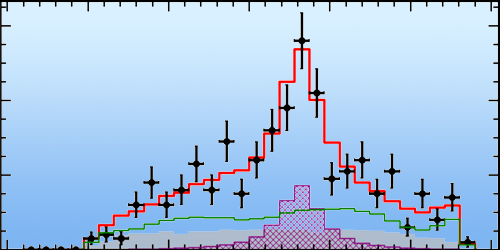A Pair of New Tetraquarks
In everyday matter that consists of protons and neutrons, all the hadrons are of the three-quark variety. But quarks can also assemble in larger numbers, showing up fleetingly in particle colliders in groups of four (see Synopsis: New Tetraquark Spotted in Electron-Positron Collisions) or five (see Synopsis: Pentaquark Discovery Confirmed). Now the Large Hadron Collider beauty (LHCb) Collaboration at CERN’s LHC has discovered two new four-quark particles. The quark compositions and charges of these tetraquarks make them good candidates for testing theoretical models [1, 2].
The LHC recently began its third operational run, but this new result is drawn from data gathered during runs 1 and 2. The LHCb Collaboration analyzed detector tracks left by charged kaons and pions, which are the ultimate products of proton–proton collisions. From these tracks, the team reconstructed decay chains in which neutral and positively charged B mesons created by the collisions decay into kaons and pions via intermediate D-meson states. The researchers found that describing the dynamics of one of these decay chains required that the system go through a pair of tetraquark states prior to forming a D meson.
In the past two decades, dozens of tetraquark candidates have been observed at the LHC and elsewhere. The newly discovered states stand out, as they are rare examples of “open-charm” mesons, in which a charm quark is present without a corresponding charm antiquark. These particles provide an opportunity to test the rules governing hadron formation. One of the two tetraquarks also includes the first observed meson with a double charge. As the other tetraquark is neutral, studying how the differing charge of the two systems affects their properties may aid in understanding their structures.
Correction (31 July 2023): The first sentence of the story was updated to clarify the relationship between protons, neutrons, and hadrons.
–Marric Stephens
Marric Stephens is a Corresponding Editor for Physics Magazine based in Bristol, UK.
References
- R. Aaij et al. (LHCb Collaboration), “First observation of a doubly charged tetraquark and its neutral partner,” Phys. Rev. Lett. 131, 041902 (2023).
- R. Aaij et al. (LHCb Collaboration), “Amplitude analysis of B0→¯D0D+s𝜋− and B+→D−D+s𝜋+ decays,” Phys. Rev. D 108, 012017 (2023).




